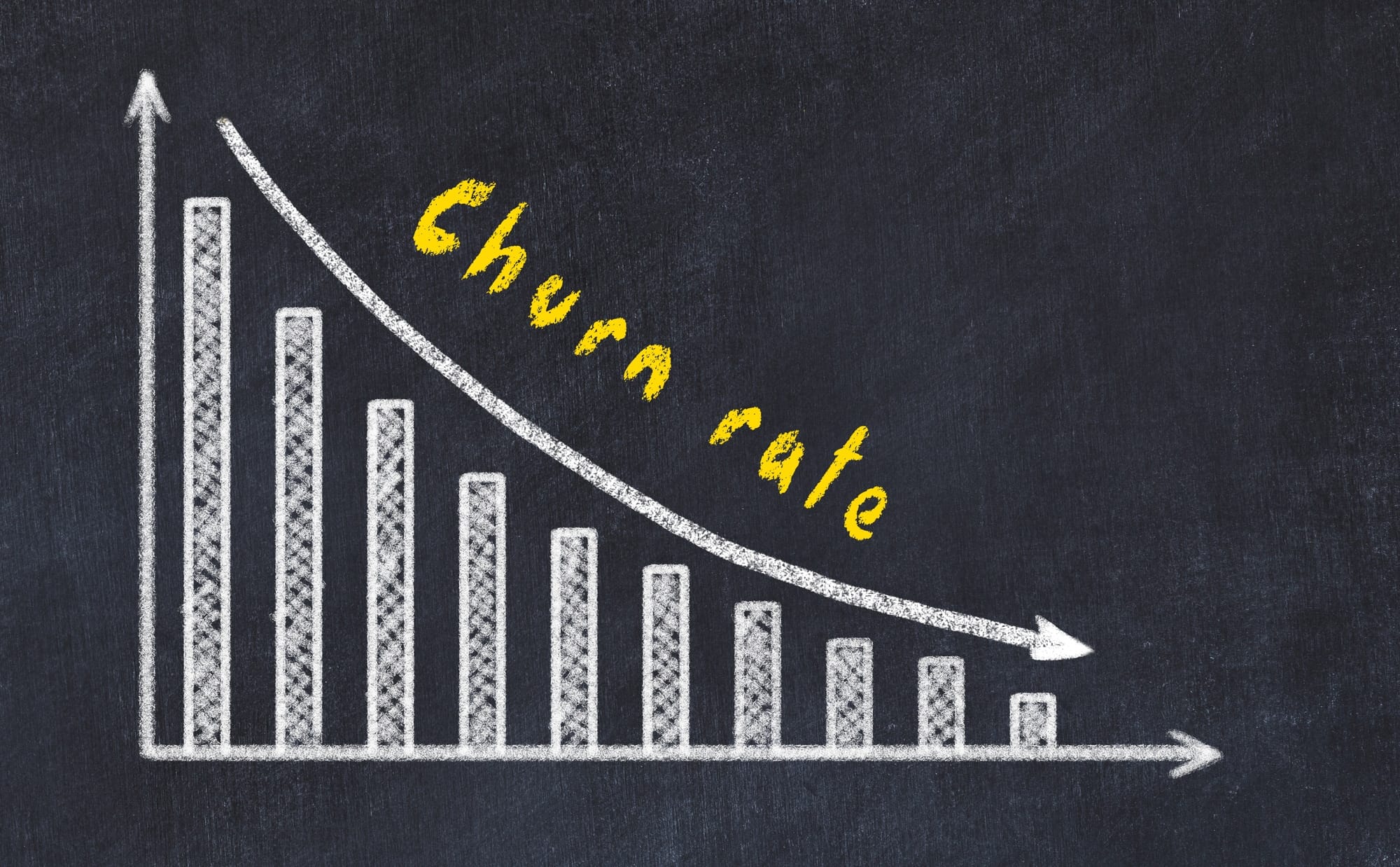Imagine you pour your heart and soul into your business, tirelessly crafting the perfect products or services, striving to create a memorable experience for every customer that walks through your door.
But here's the harsh truth. Despite your best efforts, some customers slip away, vanishing into the arms of your competitors. It's a heartbreaking reality, isn't it?
Well, fear not! Today, we're diving headfirst into the captivating world of churn analysis, a game-changing approach that empowers businesses to unravel the mysteries behind customer attrition, enabling you to keep those valuable clients from slipping through your fingers.
So, buckle up and prepare yourself to discover the astonishing power of churn analysis and how it holds the key to your business's future success.

What Is Customer Churn Analysis?
Churn analysis is like having a crystal ball for your business—a powerful tool that reveals the hidden patterns and insights behind customer attrition.
In simple terms, churn analysis examines customer behavior. It identifies the factors contributing to them leaving your business or canceling their subscriptions. However, it goes beyond merely tracking the numbers and delves into the why behind customer churn.
Imagine pinpointing the exact moments when your customers start to drift away, understanding the reasons behind their decisions, and having the opportunity to intervene before it's too late. That's precisely what churn analysis offers.
Businesses can understand the factors that influence customer churn by analyzing various data, such as customer interactions, purchase history, engagement metrics, and feedback.
This invaluable knowledge allows you to proactively retain your customers, tailor your strategies to address their pain points and build stronger, long-lasting relationships.
Churn analysis empowers businesses to make data-driven decisions, spot early warning signs, and implement effective retention strategies that keep customers coming back for more.
In a world where customer loyalty can make or break a business, churn analysis is the secret weapon that allows you to turn the tide in your favor. So, get ready to dive deep into the world of churn analysis and unlock the secrets to keeping your customers by your side.

How To Do Customer Churn Analysis?
Following a series of steps is necessary to achieve your goal when conducting a customer churn analysis, gain valuable insights, and take proactive measures to retain your customers. We've prepared a step-by-step guide to help you conduct a customer churn analysis.
1. Define Churn
Start by defining what churn means for your business. For example, is it when a customer cancels their subscription, stops making purchases, or becomes inactive? Then, establish clear criteria to identify churn so that you can accurately measure and analyze it.
2. Gather Data
Collect relevant data about your customers and their interactions with your business. This may include customer demographics, purchase history, website or app usage, customer support interactions, and other data points specific to your industry or business.
3. Identify Churn Period
Determine the time frame you want to analyze for churn. For example, it could be monthly, quarterly, or yearly, depending on your business model and customer lifecycle.
4. Analyze Patterns
Use statistical and analytical techniques to identify patterns and correlations in your data. For example, look for common factors or trends among churned customers.
For example, are there specific products or services that are more prone to churn? Are there particular customer behaviors or characteristics that are associated with churn?
5. Segment Your Customers
Divide your customer base into segments based on relevant criteria such as demographics, purchasing behavior, or engagement levels.
This segmentation allows you to analyze churn rates and patterns within each segment, providing deeper insights into the unique characteristics of different customer groups.
6. Identify Churn Predictors
Utilize machine learning algorithms or statistical models to identify churn predictors. These predictors could include variables such as the length of time since the last purchase, customer engagement levels, frequency of customer support interactions, or changes in spending patterns.
By identifying these predictors, you can spot early warning signs and take proactive measures to retain at-risk customers.
7. Take Action
With the insights gained from your churn analysis, develop targeted strategies to reduce churn.
This could involve improving customer support, enhancing product features, implementing personalized retention campaigns, or offering incentives to loyal customers. The key is addressing the specific pain points and concerns your analysis identifies.
8. Monitor and Refine
Churn analysis is an ongoing process. First, continuously monitor customer churn rates and analyze the effectiveness of your retention strategies. Then, refine your approach based on new data and feedback, constantly striving to improve customer retention.
Remember, churn analysis is not a one-time task but a dynamic process requiring continuous evaluation and adaptation.
By understanding the actual reasons behind customer churn and taking proactive steps to mitigate it, you can foster customer loyalty, drive growth, and ensure the long-term success of your business.

What Is The Significance of Churn Analysis?
The significance of churn analysis for businesses cannot be overstated. Here are some key reasons why churn analysis is essential for businesses.
1. Retaining Valuable Customers
Churn analysis helps you identify the factors that lead to customer attrition. By understanding why customers are leaving, you can take targeted actions to address their concerns and improve their experience.
This, in turn, increases the chances of retaining valuable customers who might otherwise have churned.
2. Cost Savings
Acquiring new customers is considered more expensive than retaining existing ones. Churn analysis allows you to allocate resources more effectively by focusing on customer retention strategies. Reducing churn rates can save on customer acquisition costs and improve your overall profitability.
3. Enhancing Customer Satisfaction
Churn analysis provides insights into customer behavior and preferences. By understanding your customers' needs and pain points, you can tailor your products, services, and customer interactions to enhance their satisfaction.
Satisfied customers will likely stay loyal to your brand and become advocates, driving positive word-of-mouth and attracting new customers.
4. Data-Driven Decision Making
Churn analysis is rooted in data and analytics. It enables businesses to make informed, data-driven decisions rather than relying on assumptions or guesswork.
By analyzing customer behavior, trends, and patterns, you can make strategic choices that are more likely to succeed, leading to improved business outcomes.
5. Competitive Advantage
Businesses that prioritize churn analysis gain a competitive edge in the market. By understanding their customers better and proactively addressing churn, they can deliver superior experiences compared to their competitors.
This can help differentiate their brand, attract new customers, and create a positive reputation in the market.
6. Business Growth
Churn analysis helps you retain existing customers and drives business growth. By identifying churn predictors and taking proactive measures, you can reduce churn rates, increase customer lifetime value, and generate a stable revenue stream.
Furthermore, satisfied and loyal customers are more likely to make repeat purchases, refer others, and contribute to your business's organic growth.

What Are Different Types of Churn Analysis?
Businesses can utilize several types of churn analysis to gain insights into customer attrition. Here are some commonly used types of churn analysis.
1. Voluntary vs. Involuntary Churn
This analysis distinguishes between voluntary churn, where customers actively choose to discontinue their relationship with a business, and involuntary churn, which occurs due to reasons beyond the customer's control, for example, payment issues and service disruptions.
Understanding the proportions of voluntary and involuntary churn can help identify areas for improvement and prioritize retention efforts accordingly.
2. Customer Segmentation Analysis
This type of churn analysis involves segmenting customers into several groups based on shared characteristics, such as demographics, purchasing behavior, or engagement levels.
By analyzing churn rates within each segment, businesses can identify which customer groups are more likely to churn and develop tailored retention strategies for each segment.
3. Time-to-Churn Analysis
Time-to-churn analysis determines the average or median time customers take to churn. It helps identify critical points in the customer lifecycle where churn occurs, allowing businesses to take proactive measures to prevent attrition during those periods.
4. Product/Service-Specific Churn Analysis
This analysis examines churn rates associated with a business's specific products or services.
By identifying which offerings have higher churn rates, businesses can identify areas for improvement or consider adjusting their product strategy to meet customer needs more effectively.
5. Channel-specific Churn Analysis
Channel-specific churn analysis explores churn rates associated with different customer interaction channels, such as in-store, online, mobile app, or customer support.
Understanding which channels have higher churn rates can help optimize customer experiences across various touchpoints and allocate resources more effectively.
6. Predictive Churn Analysis
Predictive churn analysis involves using advanced analytical techniques, such as machine learning algorithms, to predict which customers will likely churn.
Businesses can proactively intervene and implement targeted retention strategies for at-risk customers by identifying churn predictors based on historical data.
7. Cohort Analysis
Cohort analysis involves grouping customers based on specific characteristics or time-based cohorts—for example, customers who signed up in a particular month.
By comparing churn rates and behaviors across cohorts, businesses can identify trends, patterns, and the effectiveness of retention efforts over time.

What Is KPI In Churn Analysis?
In churn analysis, KPI stands for Key Performance Indicator. KPIs are measurable metrics that businesses use to assess their performance and track progress toward their goals.
Regarding churn analysis, KPIs provide insights into customer attrition and help businesses understand how well they manage customer retention. Here are some common KPIs used in churn analysis.
1. Churn Rate
The churn rate is a fundamental KPI in churn analysis. It represents the percentage of customers who have discontinued their relationship with your business during a specific period.
It is calculated by dividing the number of churned customers by the total number at the beginning of the period.
2. Customer Lifetime Value
Customer lifetime value measures the total value that customers bring to your business over their entire relationship. It considers the average purchase value, purchase frequency, and customer retention.
Customer lifetime value helps businesses understand the financial impact of churn. In addition, it can guide decisions on customer acquisition and retention strategies.
3. Customer Retention Rate
This KPI measures the percentage of customers who continue to do business with you over a specific period.
It is the inverse of the churn rate and clearly indicates your retention efforts' success. A high customer retention rate indicates strong customer loyalty and satisfaction.
4. Churn by Cohort
Cohort analysis is often used to track churn rates for groups of customers who share specific characteristics or join within a certain timeframe.
This KPI allows you to assess whether churn rates differ between different cohorts, providing insights into the effectiveness of your retention strategies over time.
5. Average Time to Churn
This KPI measures the average or median time it takes for a customer to churn after their initial interaction with your business.
It helps identify critical periods in the customer lifecycle. Then, it lets you focus on improving customer experiences and engagement during those stages.
6. Churn Segmentation
Segmenting churned customers based on specific characteristics or behaviors can provide valuable insights.
KPIs related to churn segmentation, such as churn rate by customer segment or churn rate by product/service, allow businesses to identify which customer groups or offerings are more susceptible to churn, enabling targeted retention efforts.

How To Reduce Customer Churn?
Reducing customer churn is prioritized by every business that fosters customer loyalty and sustains long-term growth. Here are several strategies you can implement to reduce customer churn.
1. Improve Customer Experience
Enhance the overall customer experience by focusing on areas that matter most to your customers. For example, provide excellent customer service, ensure prompt and effective issue resolution, and create personalized interactions that make customers feel valued and heard.
2. Proactive Customer Communication
Regularly engage with your customers through various channels such as email, social media, or newsletters. Keep them informed about product updates, special offers, and upcoming events.
Proactive communication helps maintain a strong connection with your customers and reduces the likelihood of them feeling neglected or forgotten.
3. Implement Customer Feedback Systems
Actively seek customer feedback to understand their needs, pain points, and expectations.
Utilise surveys, feedback forms, or customer reviews to gather insights.
Analyze the feedback and take action to address any issues or concerns raised, demonstrating your commitment to improving their experience.

How Churn Analysis Helps Businesses Keep Their Customers: Final Word
This article explores the significance of churn analysis in helping businesses retain customers. Churn analysis involves examining customer behavior, identifying factors contributing to customer attrition, and taking proactive measures to retain customers.
It allows businesses to make data-driven decisions, enhance customer satisfaction, reduce costs, and gain a competitive advantage. The article also outlines different types of churn analysis.
Additionally, it explains the concept of Key Performance Indicators (KPIs) in churn analysis. Moreover, the article also provides strategies to reduce customer churn.








